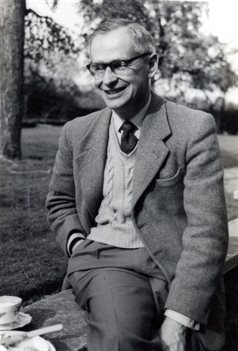 Dr. I. H. (Harry) Gosset M.A., B.M., Oxon, F.R.C.P. practised as a Consultant Paediatrician in Northamptonshire from 1947 until his untimely death in 1965.
Dr. I. H. (Harry) Gosset M.A., B.M., Oxon, F.R.C.P. practised as a Consultant Paediatrician in Northamptonshire from 1947 until his untimely death in 1965.
He was the son of a renowned statistician, ‘student.’ He was educated at Rugby School, England. He was a Demi (Scholar) at Magdalen College, Oxford and MacKenzie exhibitioner at St. Thomas’ Hospital, London.
For his obituary in the Lancet, a colleague wrote “The most modest and patient of men, he was completely dedicated to paediatrics. His knowledge was profound and it was a delight to see him handle a sick child. He wrote little but was a gifted teacher, and his Saturday morning rounds were attended by GPs and MOHs from town and country”.
In an era when research was making dramatic discoveries in his specialty, it was his ambition to build a level of paediatric care in a provincial hospital as good as that of a teaching hospital. In this he succeeded. The Unit For Premature Babies, which he designed and saw through to completion at Northampton General Hospital, is his tangible legacy, giving vulnerable newborns, who hitherto would have died, the chance to live full, long and meaningful lives. It has most fittingly been renamed the Gosset unit in his memory. The children of this county also benefited from this excellent care directly, or indirectly through the generations of staff that he trained. Both are his intended legacy.
The Gosset Collection is an online repository of his work illustrating exemplary general paediatric and premature baby care (1947-1965) with material kindly contributed by his family, colleagues and friends.
International interest
After his death, Dr Gosset’s family collected and stored his correspondence. Amongst these was a large collection of requests from other doctors around the world for either a copy of his Lancet paper or information on how to get an icterometer of their own. These request cards and letters have been sorted and entered into a database, to show the global spread of this device.
To make this more easily visible the data has also been turned into a map.
This is not a full list of everyone who purchased an icterometer. Correspondence from Thomas A. Ingram & Co, the manufacturer, indicates sales of over 1000 by January 1961. It particularly highlights high sales levels in places like Australia and Japan, with enquires even coming from beyond the Iron Curtain. Which is not represented in this collection of correspondence. Perhaps their letters went straight to the manufacturer.
Several individuals also requested an icterometer in order to conduct their own research.
Here you can see the digitised images of Dr C.R.J. Ruthven’s letter, as he describes how he carried out a trial of the use of the icterometer, and essentially replicated Dr Gosset’s original results.
It also gained international interest for research, with both Dr Barton, and Dr Crosse requesting icterometers to carry out research on Hyperbilirubinemia in premature infants.
The icterometer is still used today in several countries, and the international spread of the device and the research around it, was an important part of the early development of neonatal care.
Dr Gosset Collection
Vodcast